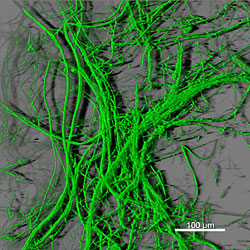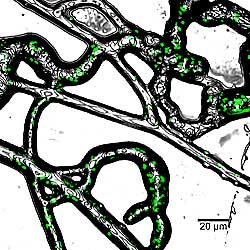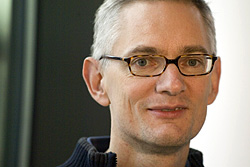Press release, 8. February 2007
Taking the fungal route through the soil
Scientists demonstrate the existence of underground ‘highways’ for bacteria
Leipzig. Fungal hyphae play a greater role in the spread of bacteria in the soil than was previously suspected. This is the finding reported by scientists from the Helmholtz Centre for Environmental Research (UFZ) in the scientific journal Environmental Science & Technology. For the first time, scientists have been able to prove that bacteria are able to travel through the soil on the mucous membrane of living fungi. The experiments could help speed up the remediation of contaminated land using bacteria that break down harmful substances. Air and a lack of moisture create a barrier to the mobility of bacteria in the soil, preventing them from spreading and delaying the breakdown of pollutants.

Photograph of the soil fungi Fusarium oxysporum with a laser scanning microscope (high resolution pictures can be obtained
on demand over the press relations department)
Foto: Dr. Thomas Neu/UFZ

Bacteria on a mycelium (high resolution pictures can be obtained on demand over the press relations department)
Foto: Katrin Pötzsch/UFZ

Dr. Lukas Y. Wick, Department Environmental Microbiology, UFZ
Foto: André Künzelmann/UFZ
Everything is just a question of contacts
It looks like a giant green ball of wool. With a bit of imagination the photo could also be likened to a huge motorway interchange with countless roads and junctions passing over and under each other on different levels. But what Leipzig-based microbiologist Dr Lukas Y. Wick is observing so intently on his screen is in fact a photograph of a mycelium taken with a confocal laser scanning microscope. The thread-like hyphae have a diameter of just 10 micrometres – one-seventh of the diameter of a human hair. Nevertheless, fungi are some of the world’s greatest biomass producers. A single gram of field soil can contain up to 100 metres of mycelium. Wick’s actual research objects are much smaller still. He is interested in soil bacteria. Bacteria can weaken the human organism, but they can also be useful, e.g. by breaking down pollutants. “For the bacterium a harmful substance is not harmful,” explains Wick. “It simply breaks down the carbon compounds, producing the energy and substances that it needs to live.” But before it can do this it has to get at its ‘food’. Air and lack of moisture present insurmountable obstacles. “This is why certain pollutants are broken down so slowly in the soil. Often it is not a lack of biochemical capacity, but rather a lack of contacts.” The scientists at the UFZ are therefore studying the paths followed by the bacteria.
Probably the world’s largest motorway network
Mycelia appear to act as a kind of underground highway for bacteria. This is the conclusion reached by Lukas Wick and his team. In the laboratory experiment they succeeded in demonstrating that the bacteria move through the soil on the mycelium. The ingredients: one pollutant, separating layers made of glass pellets, uncontaminated soil and a bacterium called Pseudomonas putida. The bacteria have to fight their way through all these layers to reach the phenanthrene, their ‘food’. This polycyclic aromatic hydrocarbon is a widespread pollutant produced during every combustion process: at petrol stations, in car exhausts, during forest fires, in cigarette smoke and in old municipal gas works. “We deliberately make the bacteria work their way upwards against gravity so that people can’t say there could be a small amount of water trickling down and carrying the bacteria with it,” says Wick. “We have tried to rule out any doubts and objections from potential critics.” The bacteria made it to the top only in places where there was a mycelium running through the soil. In the identical parallel experiment without a mycelium the bacteria were unable to surmount the barriers. “With this paper we have shown that there is an infrastructure.”
Just follow your nose
The bacteria in this laboratory experiment are so-called chemotactic bacteria. This means that they measure the concentration of their ‘target chemical’ and then move towards where the concentration is higher – as if on autopilot. “A bacterium is not a stupid creature – it has adapted to its environment and goes where there is food.” Only one type of bacteria was used in the model experiment. In nature, however, there are countless different bacteria, which gives rise to new questions: for which of them is it an advantage to be mobile and for which is it not? It will, therefore, be some time before the processes in the soil are fully understood. The future aim of the Helmholtz researchers is to model microbial landscapes and to investigate what happens under the influence of different factors. For this they will make use of a tool that has already helped to predict the spread of rabies and the spread of resettled animal species – ecological modelling, which in future will also be able to provide forecasts about the spread of bacteria. This knowledge will make it easier to remediate contaminated soil, perhaps making the ‘fungal highway’ not only the largest in the world, but also the only one to help return nature to its original state.
Tilo Arnhold
Publications:
"Effect of Fungal Hyphae on the Access of Bacteria to Phenanthrene in Soil"
Environ. Sci. Technol. 2007, 41, 500-505
here
"Taking the fungal highway: Mobilization of pollutant-degrading bacteria by fungi"
Environ. Sci. Technol. 2005, 39, 4640-4646.
here
Links:
Background: Contaminated soil and groundwater:
download
Background: Microbial Biodiversity
download
More information:
Dr. Lukas Y. Wick
Helmholtz Centre for Environmental Research - UFZ
phone +49 341/235-2523
e-Mail: lukas.wick@ufz.de
www.ufz.de/index.php?en=4185
Public Relations of Helmholtz Centre for Environmental Research – UFZ
Tilo Arnhold / Doris Böhme
phone +49 341/235-2278
e-mail: presse@ufz.de
